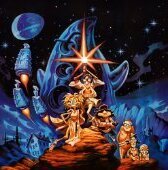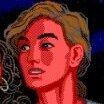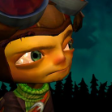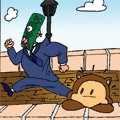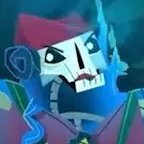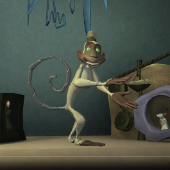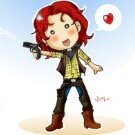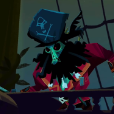Leaderboard
Popular Content
Showing content with the highest reputation on 10/10/22 in all areas
-
Earlier today, Laura Cress interviewed Ron on Return to Monkey Island and got into full spoilers, specifically the opening and ending: https://www.youtube.com/watch?v=LHmnvnfhHjw&ab_channel=Cressup Ron talks openly about the Secret and what has been in his mind for the last 30 years. It feels so good that Ron is finally free to talk openly about this topic after so many years and to hear his full thoughts. He also clarifies a lot of other aspects as well, such as his thoughts on the series continuing.4 points
-
I finally repainted that damn bread. (The surrounding area will be touched up later)3 points
-
What I loved about the interview in particular is how Ron really stuck to his guns regarding the Secret. He didn't say, "Well, the Secret is that it's truly up to interpretation but you can find evidence to support....," or anything like that. He specifically brought it up right as the ending began and confirmed that this is in fact the Secret people have been wanting to know for decades and what he had originally envisioned. I think the game makes that clear, especially that plaque at the end, but this was the last bit of closure I needed. This also lines up quite well with comments Ron has said throughout the years in various interviews. The original concept of the first game became too big and ambitious to reveal everything within one game, so they created a series around it to segment some of its themes and aspects. Ron didn't have all the specifics of the journey mapped, but the Secret was always there in his mind. It's great. My take on the multiple endings is this - had the third game by Ron came out relatively shortly after MI2, the ending would've probably be much more streamlined with one definitive one, perhaps with some wriggle room on certain things but not to the degree that we got here. But with 30 years of this series becoming so much more for so many more people and Ron and Dave really honing their craft as designers and writers, they wanted to be definitive with the Secret, but also allow multiple interpretations for many other aspects of the game with the inclusion of 10 endings. I'm actually very happy and appreciative that he didn't reveal which one he views as canon. If I had to guess, it would be the one that implies that Guybrush takes his family to the amusement park to finally share the experiences with his son and come full circle.3 points
-
I’m going to guess they don’t think any one of them is “canon.” I know that’s annoying, but I strongly guess it is true. This game was very deliberately made, and I can’t imagine they went into the end thinking “okay we’ll make the real one, and then six other ones that don’t really sound in our eyes.” My own personal example here, which is maybe relevant maybe not: I worked on The Walking Dead season one at Telltale, it was one of the few games I’ve worked on that had multiple things that could happen at the end. Similar to Return, they are narratively contradictory but thematically all on the same wavelength. I know how they work under the hood – what triggers them, what paths players had to walk and what choices they had to make to get the different endings – and I don’t consider one any more valid than another. It just wasn’t how we thought about the game or story when designing at.3 points
-
3 points
-
Ron actually confirmed on Twitter it's not possible to complete the "murder those who get in your way" one in the pamphlet.2 points
-
I'm starting to even take the ending of the second game was Guybrush accidently finding the maintenance tunnels of the park and his imagination/reality comes crashing down as a result. He realizes that it's just a park, but to sustain the illusion, he comes up with the plot points of the park being one of LeChuck's schemes to build up his undead army, with himself being under a hex of LeChuck's creation, and the tunnels connecting islands together. Then his son takes it further and puts another spin on it upon his reimagining of it with his friend Chuckie. At the end of Return, Guybrush was so entrenched in his imagination, it took him a few minutes to realize that he is still just in a park, even if it's the umpteenth time he's been there. Perhaps even Guybrush and Elaine got married there if that's where they met and he proposed to her. It would be a modernized concept since more and more couples are getting married at places that mean something significant to them as a couple and not the typical venues. The dream of Guybrush's parents from the second game are indicative of his feeling of abandonment and loneliness. They left him when he needed them the most and was raised in an orphanage. The park was an escape from these feelings for him, but they are still there, deep down. Those feelings come up in the dream and at the end, when he finds their skeletons. They are gone/dead in his life, perhaps even literally. So now, he wants to share those tales with his son and experience the park together as a family. Maybe Guybrush's thoughts at the end with just him on the bench was him thinking "Perhaps it's time I take Boybrush to the actual amusement park." The Secret and Big Whoop are all just in-depth carnival games. The prize for Big Whoop was an E-Ticket and the Secret was a t-shirt. Even the Voodoo Lady's agenda from Tales could be Guybrush's take of her being a prominent amusement park worker who creates the scenarios and stories of the park and the battles with LeChuck.2 points
-
Now that the dust has settled, I'm ranking the game a little lower than I would've thought. That's not to say I didn't really, really, really like it, but it has more to do with how little new ground it treads. Most of the locations we've already seen in other Monkey Island games, and the new locations don't really feel quite as inspired or detailed as the old ones. A lot of the themes have been done before too (by EMI no less!), maybe not as effectively, but the overlaps are there. The graphics are nice and the compositions and details are wonderful! I'm just still not a fan of tween animation, and while it was expertly handled, I still just see shapes tweening back and forth. I guess it's a compromise that has to be made if you want 2D animation in this day and age, but I just don't like it. About the ending: I really love the humour, the music and the ambience, but I can't shake off the feeling that It's retreading some of the same ground as in MI 1, 2 and 4. On that note, it's not in my top 3. That'll still be SMI, MI2, CMI. That being said, I had a great ride! And the fact that, to me, it doesn't reach the hights of some previous titles, doesn't mean it's not a great game! I'm really impressed by the accomplishment of Ron and his team! Chapeau to them, and I love the product that they've made! Now gimme a physical edition with a soundtrack CD!2 points
-
I feel like none of these post-credit scenes are mutually exclusive. I'm sort of falling in love with the rock and the banana. It reminds me of Herman's primitive art in SMI, which has the same shape and looked precarious, but was actually pretty sturdy. It was also the vehicle through which Guybrush could choose to sink his ship or not. And the rock and banana further makes me think of SMI Part 3 on Monkey Island itself, where banana and rock are both inventory items, which makes me remember the mystique of being on that island originally. I have no idea if Ron and Dave intended that with the rock and banana, or if it was a throwaway. But I am confident that cutscene can co-exist with any of the other scenes. Unrelated edit: Ron has said his favorite playthrough of The Cave is the Hillbilly, the Twins, the Scientist. I'm not surprised. The Hillbilly holds his breath indefinitely, and his level is a carnival of cardboard-cutout people.2 points
-
Well MI2 was sort of shy about it, if you think about it. It revealed the theme park, but added the twist that it was a spell. I asked Ron and Dave specifically if MI2 was always the ending on Twitter, and they both said no. And Ron has alway thought of MI2's ending as something else. (As he describes in his PAX talk.) I think MI2's ending took an ingredient of the original "secret", but turned it into something different (although to us, as outsiders, it feels very similar). Until the game literally said, "yes, you're in a theme park", the secret wasn't fully revealed. My question for Ron would be: What was your explanation for having Guybrush turn into a child when you wrote MI2? Did you have one, or was it just a quirky way to end the game?2 points
-
Agreed. Which is why it's such a tease to go and say "One of these endings is my personal interpretation of what really happened." (paraphrasing) Why would he do this to us!! 😛2 points
-
2 points
-
I haven't had a lot of time to look at this, but going through the "EndStingers" resource files, there was only one that looks unfamiliar to me. It involves Guybrush crumpling up a document. The KTXBZ file looks like so... Odds are that I'm spacing on something or simply that others got this ending while I didn't. Or?1 point
-
I wonder if it was at one point though. That squid positioned itself as your enemy only to die when you weren’t looking. Maybe originally guybrush killed the squid, which checked off the pamphlet, which unlocked the new ending, which killed the cat that ate the rat that lived in the house that jack built.1 point
-
I finished the game still feeling that endings like "Chucky and Dee chase each other for the key" could co-exist with endings like "LeChuck and Lilah battle each other for the chest", both of them real and fictional at the same time. Then I watched this interview, and Ron says he thinks one of the endings is more true than the others... and he goes on to say that Dave probably thinks a different ending is more true. Heh. Around the 52 minute mark, Ron says he originally conceived that a villainous amusement park owner had Guybrush trapped, and Guybrush had to figure out he was trapped in the amusement park to defeat the owner and triumph. And eventually this park owner evolved into what became LeChuck. I do wonder if that was conceived before or after the concept of Governor Fat sending pirates to discover the Treasure of Monkey Island, which turned out to be not a monetary treasure but a crack in the earth into "hell", which turned the living into the undead. https://archive.org/details/ComputerGameDesignDOcuments/Aric Wilmunder - 1990 Mutiny on Monkey Island/mode/2up To me? That's the most compelling Secret of Monkey Island. It's harder for me to believe that Herman and his Captain sailed to discover that the world was an amusement park, or that LeChuck sailed to learn the world was an amusement park and coincidentially became a Ghost Pirate while the pirates of Mêlée Island (i.e. Estevan) believed he had successfully learned the Secret when he actually hadn't. Mutiny on Monkey Island, p. 3, is the secret I learned and choose to believe. In MI6, I think the closest thing to it is "There's not just one Secret", with the banana and the rock. The banana and the rock take me back to 1990.1 point
-
I just released an update, version 0.2. Now packing files should use far less memory. And you can add filename filters so you don't have to unpack the entire ggpack, but you can for instance do 'unpack Weird.ggpack1a *.tsv' to just get the translation files. I also rewrote and expanded the included readme, I hope it's more clear now and explains everything, without being too wordy.1 point
-
Oh, I didn't see that. My bad, then. I guess it does mean than, even though Guybrush can be terrible, he would never commit murder. I like that.1 point
-
1 point
-
Could be a cut ending -- like I said, this is an end stinger, marked as #1, Docs.1 point
-
I posted this previously, but my ranking still stands:1 point
-
To me, this doesn't add up, though, because the amusement park "secret" has been revealed at the end of MI2. Why bother all these years to keep shy about telling what the secret is, when he's already revealed it?1 point
-
I absolutely love your covers, thanks for sharing techzpod download mobdro1 point
-
Well, the twist was, of course, that she wasn't a damsel in distress in SOMI.1 point
-
Wow, hearing ron talking openly about the secret and how it changed/stayed the same from the original game is so, incredibly satisfying. Like, I know that an interpretation of the game's themes is that, whatever the secret was, it was going to be unsatisfying. But for me, hearing this, it's just so nice to finally get some closure.1 point
-
Okay, now I want to know which of the ten endings Ron (and Dave!) thinks is 'cannon'! Not that it matters or anything...1 point
-
It's been a long time since I visited the old Mojo forums. I must say. The new Monkey Island is ffing fantastic.1 point
-
I had to squeeze this wonderful promotional artwork for "Dark Forces" in. Painted by David Grove, this was used for print ads in several magazines back in the time. Interestingly, the original painting was created with much brighter colors, and later darkened for printing. Surely this was intentional, as the art works much better this way, given the game it was created for. I've created several different versions for this:1 point
-
As I kept reflecting on the ending, some new thoughts have sprung. This will be an enormous post, soI’ll be truly grateful to those who manage to read the whole thing. So called “metanarratives” have been told before, across various mediums, whereas by placing the audience as the unwilling target of some sort of storytelling, fourth-wall breaking pun, or resorting to the “it was all in the main character’s head and imagination all along” angle. Regardless of how masterfully conceived these “metanarratives” can be (whether in the form of books, movies, etc.), there is inevitably a gap, a distance, between what the characters are experiencing and what is our own reaction to those experiences. A good storyteller will diminish that distance, create greater empathy between the audience and the characters, but we are still outside witnesses, external observants. We can be touched emotionally by the story, but that tends to come down to how much empathy has been conjured between us and the characters, on how much we can imagine ourselves in the characters’ shoes, on how much we can “relate”. However, I feel RTMI takes this to a whole new level, using a storytelling method that is a particularly perfect vehicle for exploration of this kind of thematic undercurrent: the point and click adventure game. This goes beyond the mere notion of being able to control where the main character goes, or how long we can linger in certain places or even the choices of dialogue (within the obvious limitations of the game framework). Those are just the mechanical and functional means of the storytelling experience. We learn, in what I think is a pretty definitive and unequivocal conclusion, that the world of Monkey Island is a plateau of existence, a mental place, a dimension, if you will, where Guybrush finds solace, refuge, escapism and entertainment. I won’t go into the discussion whether this dimension is any more real than the one where his everyday existence is taking place. What seems pretty definitive to me, is that those two dimensions are separate, they are two different things, although elements from the “everyday dimension”, to a certain extent, seem to feed the fabric of the Monkey Island dimension (and probably vice-versa. as well), as the things we experience almost subconsciously in our everyday lives can also feed our dreams. This Monkey Island dimension might have been triggered by Guybrush’s experiences, both as a child and as an adult, in a pirate themed amusement park, as a way to escape from a reality that is either too sad, too painful, too dull or too empty to face without solace. The details really don’t matter. And this is where the “metanarrative” comes to its full fruition. We are not witnessing Guybrush escaping into an imaginary pirate world, as he tries to take some reprieve from his everyday existente, while feeling empathy for his plight. No, we are Guybrush! As much as I ever felt in any work of art, we are indeed the character. We are not empathizing with Guybrush, we are not relating to Guybrush. We truly are Guybrush. We are the ones looking for solace, refuge, escapism and entertainment in a fictional pirate world. We are the ones (particularly in this forum of such dedicated fans), who treasure and look forward to the moments we spend in this Monkey Island dimension. We don’t do it to spend the time while waiting for the train to arrive. We don’t do it because there’s nothing else to do. We don’t do it to fill in the blanks in our daily schedule. We make it a pinnacle of our leisure time. It’s primetime worthy. In those playing hours, we rather be in the Monkey Island world than in whatever real life has to offer , regardless of how happy or fulfilled we feel. I don’t play Monkey Island the same way I play other games. Not even in the same way I play other point and click adventure games. It’s not to reach the end, get a dopamine fix or an adrenaline rush. I play it for the experience, to live in that world for a bit. That’s why I like linger in the wonderfully evocative locations, just wander around the locals, why I look forward wish to get stuck certain puzzles, so as the music and ambiance seep through my skin and become engrained, so as to when we listen to the soundtrack, it will immediately conjure up memories and feelings of those precious moments spent in the Monkey Island dimension. And I know Monkey Island is not real. Guybrush knows Monkey Island is not real. But it is true. And it matters. And that’s why we like to discuss the minutiae of this world, what things are “more real” than others (although nothing of it is really real), why we hang posters of it on the wall, listen to the soundtracks, replay the games knowing by heart all the solutions to every single puzzle. We want to keep visiting the same amusement park, we get excited when there’s a new ride on the horizon and we love riding the same old, well-worn, familiar rides.. And when not in the amusement park itself, we reminisce by looking at ticket stubs, park maps, promotional brochures. And I, like Guybrush, want Monkey Island to be as real as possible. So I keep chasing the horizon, clinging on to every small thing that might make it a little bit more concrete. I want to make LEGO models of Melee Town, the Giant Monkey Head and Woodtick. I want character statutes to proudly display on my bookcases. I want to wear T-Shirts of the Legendary Treasure of Melee Island. But it is not real. It 's not concrete. It can’t be. And just like Guybrush, I felt disheartened when I reached the back alley of Melee Island at the end of the game. It’s time to go home. My day at the amusement park is almost over. No more new rides to try. It’s with heavy hearts that I turn off all the lights in the park. I have to get back to my more mundane existence. But this game gives us something absolutely new. Almost revolutionary. It shows us a Guybrush with a life outside of Monkey Island. And a happy and fulfilling life at that, with a beautiful family. And we realize, maybe for the first time, that Guybrush doesn’t really need Monkey Island anymore. He’s ceased to be obsessed by it. And this is where The Secret comes in. And how it really could never have been something of true importance. It was a red herring all along, a distraction, something with an importance that grew in an unwarrantedly disproportionate manner throughout the years. It was ever only something that was part of the fabric of Monkey Island, among many other things. It was never its raison d'être, never a cipher to understand the whole thing. Monkey Island is not a mystery to solve, but a “reality” to experience. Like life itself. Lechuck lost sight of this. Monkey Island ceased to be a “good place”, where one could have sprawling adventures, meet colorful characters and visit fascinating places. It was all about The Secret, looking for some sort of resolution, an answer, something with which to cover the gaping holes in his existence. At the end of the game, Guybrush is finally freed from this anchor (ohh, symbolism). He can now visit Monkey Island because he wants to, not because he has to. It’s something that adds to his life, it doesn’t replace it. And it has become a pure thing again. A place where he can play pirates, simple as that, only constrained by the limits of his imagination. Stories being told around a campfire. In light of this, the very beginning of The Secret of Monkey Island has become even more perfect. Guybrush arrives at Melee Island not by ship, but by walking through a stone archway, as it were some sort of portal, and declare bluntly and plainly: This is all we want. We are Guybrush from the very start. We want to be pirates in a make-believe world. That’s why we are playing. Even the setting is perfect. How else would a Pirate setting be enticing unless when seen and interpreted by a child-like imagination? Throw any serious degree of historicity in it and the whole thing crumbles, with all the pillaging, violence, depravity and filth involved. It has to be a Pirate universe as imagined by a child. Again, it was never about The Secret. The whole point of experiencing Monkey Island is perfectly captured by the very first thing Guybrush says. There can never be a Monkey Island prequel. There’s no other possible beginning. To do it would be to corrupt it. Nothing exists before that declaration of intent. That’s where the whole dimension of Monkey Island is born. “I want to be a pirate”. That’s the absolute summation of what Monkey Island is all about. At the end, Guybrush (and myself), realize there’s peace to be found in knowing there’s no deeper meaning behind all of it. Monkey Island is a “good place” to visit every now and then. Guybrush has regained the purity of intent shown in that very first scene in The Secret of Monkey Island. The whole thing has become unburdened by overarching narratives, unsaddled by strict continuity between adventures, freed at last from the shackles of having to provide answers and meaning. Elaine emphasizes this by suggesting yet another adventure. Of the simpler, purer kind. And how perfect and crucial that little intervention is. Brings the whole thing full circle. And Guybrush sits on that bench, looking truly at peace with himself (as I see it), having regained the true purpose of Monkey Island. That image is the perfect coda to the Ron Gilbert trilogy. The lookout scene in SOMI as an overture. This is one as an epilogue. The world of Monkey Island is now wide open. There was never a better time to create new stories in it. Purer stories. With more cannons and less “canon”. I became a father 6 months ago. A little Boybrush named Manuel. Like Guybrush, I now have a family to share the world of Monkey Island with. And it has become something new again.1 point

